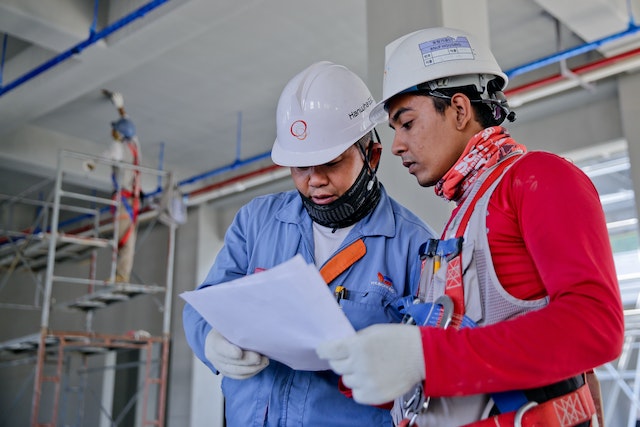Featured image: Photo by RODNAE Productions from Pexels
Preamble
“Psychological safety is the belief that one will not be punished or humiliated for speaking up with ideas, questions, concerns or mistakes and that the team is safe for interpersonal risk taking” - Psychological Safety and Learning Behavior in Work Teams by Amy Edmondson, 1999.
That is an impressive definition and one that is easy to understand by anyone who reads it.
Having read that now, do you feel that you work in a place that gives you the psychological safety to be yourself? The answer is extremely important because if it is a NO, maybe you should look for a new job.
Why is psychological safety so important?
In order to discuss the why, it is good to understand what would happen if you had the feeling that you could be punished or your opinion could be ridiculed for speaking up? What comes to your mind first?
- Embarrassment
- Bad or silly reputation for asking questions or giving suggestions
- Could I be fired?
- Am I that bad?
These are some examples of thoughts that I experienced when working in a place with barely any psychological safety. It is safe to say that everyone has different thoughts and hence that list might look very different for others.
A lesson from history

Have you ever wondered what caused one of the world’s deadliest nuclear power plant disasters at Chernobyl back in 1986?
Ever thought what could have prevented it? Or even what could have mitigated the damage in the aftermath?
Of course you might just say, good engineering would have prevented it.
But did the smart people who were working on the project not know of the problems surrounding the design of reactor? Could they have contained the disaster better?
If you have watched the Chernobyl - TV Mini Series you would understand the conditions at the reactor. By the way I usually would not rely on a movie or a TV series as a reference but this was a critically acclaimed TV series that portrays the disaster and the story behind and the aftermath as accurately as possible.
On the day of the disaster, the supervisor was warned of the problem with the approach for testing that he suggested by others in the room, mostly those junior to him. But the supervisor just said “I have been doing this job for a lot longer than you” and threatened his comrades/co-workers that they would be fired if they disobeyed his orders. And as the disaster unfolded, employees just wondered who would be the scapegoat in the end - the one to be blamed for the disaster.
The investigation of the disaster conducted by the International Atomic Energy Agency in Chernobyl in 1986 as part of the International nuclear safety group, introduced a term called safety culture.
The collection of beliefs, perceptions and values that employees share in relation to risks within an organisation, such as a workplace or community. - Safety Culture on Wikipedia
The lack of a good safety culture often becomes apparent only after a major accident or disaster.
Is Safety Culture the same as Psychological Safety?

No. It is not the same.
You have already seen the difference in definitions earlier in this post.
But psychological safety is crucial in creating a good safety culture.
So why did I mention the Chernobyl disaster here?
The culture in USSR at the time did not encourage anyone raising concerns or speaking up about mistakes. The reason I mentioned the scene at the reactor on the day of the disaster is to demonstrate the culture there. In such an environment, mistakes are covered up. This also makes learning difficult because we often learn to do things better from the mistakes we make.
Thus the Chernobyl disaster is a great example of the magnitude of destruction that could happen in the absence of psychological safety
- a series of warning signs could be ignored
- good ideas and suggestions could be shot down
- employees would generally be programmed to obey orders and would not dare come up with solutions
These are just symptoms of the lack of psychological safety.
What does this have to do with software engineering?

You might wonder what this has to do with Software engineering. This is a post in a blog called Software Craftsperson!
Disasters in software do not often end up killing people. Unless it is in something like a safety critical system - like aeronautical/aviation software or something in the medical field.
What about an example of the lack of psychological safety from the software industry?
You could argue that the dieselgate was an example of how the automotive industry gamed the standards by creating software that would help cheat the emissions test resulting in higher emission cars being certified as conforming to the modern stricter regulations. You would think, someone would have blown the whistle earlier.
It is worth reading about the Volkswagen Emissions scandal on wikipedia.
Volkswagen chose the “lean NOx trap” for their turbo-diesel Golf and Jetta models, but the solution did not work well as it required a fuel-rich exhaust gas in the purification process and fuel economy suffered as a result.[48] Nonetheless, the company promoted the technological miracle of fast, cheap, and green diesel vehicles – but the impression projected to outsiders did not reflect the reality.[48][52] In reality, the system failed to combine lower fuel consumption with compliant NOx emissions, and Volkswagen chose around 2006[53] to program the Engine Control Unit (ECU) to switch from lower fuel consumption and high NOx emissions to low-emission compliant mode when it detected an emissions test, particularly for the EA 189 engine.[48] This caused the engine to emit NOx levels above limits in daily operation, but comply with US NOx standards when being tested, constituting a defeat device. [50][54] In 2015 the news magazine Der Spiegel reported that at least 30 people at management level in Volkswagen knew about the deceit for years, which Volkswagen denied in 2015.[55]
The lack of psychological safety often promotes or sets a blind eye or a deaf ear to an unhealthy situation or practice. For a scandal like the diesel-gate, it is no surprise that most people knew what was going on but did not and would not raise questions or concerns.
How psychological safety is crucial for a creating safety culture
If you look at what is done to establish a good safety culture and compare that to what’s involved in creating psychological safety, you realise that there is indeed a lot of overlap!
Let’s take a closer look.
What is required to create a safety culture?
A quick online search on how to develop a safety culture will bring up plenty of results stating different steps to create one. All of them have some overlap.
- All involved have a shared understanding what is right and good for the organisation
- Everyone is comfortable stopping or challenging everyone else in case they think the consequences of the action being proposed would put the organisation at risk.
- Continuously learn, challenge and rethink processes at the workplace
- Celebrate wins
I think you get the drift now. This is looking a lot like building a team charter and learning from regular retrospectives or a feedback loop! That’s pretty much done in every software company these days! Great! I hope you get the point now. I appreciate we haven’t discussed how to create or promote a good psychological safe environment in a team just yet. We will get there.
What are the benefits of psychological safety?
The State of Devops reports consistently show that psychological safety is an essential foundational factor in software delivery team performance and to organisational performance.
In order to have a real team, you need trust among the members and the leaders. Google’s research on high performing teams found out that the common factor among all the high performing teams were psychological safety.
Based on the research published in Psychological Safety and Learning Behaviour in Work Teams by Amy Edmondson, 1999, it is evident that our evolutionary adaptations explain the fragility and the importance of it.
In a psychologically safe environment, we often have a tendency to act first and think later. I appreciate this may not sound like the best approach in life sometimes. But if you get to a point where you cannot act at all out of fear or just the feeling of not being considered seriously, your brain shuts down perspective and analytical reasoning. In a real life threatening situation, this psychological behaviour - fight or flight - might save us. But in an organisational context, it blocks our strategic thinking ability.
Is psychological safety sufficient to build a great culture?
No.
Psychological safety is crucial in an organisation but it is not the only thing that you need to develop a great organisation.
What it is not
Psychological safety does not mean a very nice workplace or or one that lacks conflicts or one where you aren’t accountable. I think some people tend to misunderstand psychological safety and hence go full on command and control in their leadership style, thinking psychological safety is bad.
What it is
Psychological safety guarantees that people will be happier to be themselves around their colleagues and hence, will be happy to challenge ideas of their bosses or their peers, will bring views that might not be the most popular but are indeed valuable when considering alternatives to a solution. The discussions will have varied view points, there will be agreements and disagreements but done respectfully.
In fact, the key is to understand that psychological safety is not the end-goal. It is a means to achieving the end-goal.
According to Amy Edmondson, you need a sense of urgency, commitment to excellence and psychological safety to build a great organisation that people love to work. Having just one of those won’t be sufficient.
How can I build psychological safety in my team?
Google did a massive 2 year study on team performance, which revealed that the highest performing teams always had psychological safety as a common factor.
But building psychological safety in your organisational culture or your team is not a simple task. It takes time and maybe reinforcing ideas around the concept. Some tips I have learned from Google’s research and Harvard Business Review article on High-Performing Teams need Psychological Safety: Here’s how to create it by Laura Delizonna around building psychological safety are what I am going to summarise below. All the 6 ways of building psychological safety are suggested by Paul Santagata, the Head of Industry at Google. Let’s take a look at them.
The six steps to building psychological safety

1. Accept conflict in healthy collaboration
Develop a culture where conflict of opinion is viewed as an ingredient of collaboration and not as an adversary. As a leader you can discourage the fight or flight reaction by a very simple question: How could we achieve a mutually desirable outcome?. I really love this idea and this is something I have used in my teams when I see a conflict, trying to deflect the focus from personal opinion to the desired outcome. It has always worked although I might not have asked exactly the same question, something along the lines of “What are the pros and cons of each approach and let’s see what’ll get us what we need in the best way possible”
2. Empathy is important
Regularly coach team members on the importance of talking human to human. Understand that your co-worker is just like you and needs respect, competence, social status and autonomy. This helps create the much needed empathy in any team, often helping people understand where the other person is coming from. This is another technique I use quite often in my 1-1s. Probing into why someone is upset about a decision and what was the trigger and trying to ask questions from the other person’s point of view, i.e. the view of the one who is not in the room. This allows the disappointed person to vent out their frustration and at the same time, gives them an opportunity to look at the other perspective with a calm mind in the presence of a neutral listener.
3. Anticipate responses and alternative views
Quite often writing down a proposal of the solution along with other considered choices help the reader know that you have considered the solution from different points of view and your approach was not biased. Now imagine, even if the solution was biased, the proposal which is now in written form, can be shared with the wider team. This encourages feedback and alternatives that might not have been considered originally to be included and even debated over in the document. We use this approach in my current organisation, collaborating on a google doc or confluence article that was published through comments, replies and revisions of the original. Thus by writing your thoughts down, you are forced to anticipate responses and alternatives asynchronously. This helps create a culture of respectful disagreement and this has helped surface some very significant issues with the original proposal many times!
4. Hello Curiosity, Goodbye Blame
I have been fortunate to now be working at a blame free organisation. However, I completely understand that not everyone is as fortunate. Blame culture kills psychological safety as it leads to the thinking of who is the best scapegoat here. Mistakes happen all the time. As humans, we all make mistakes on a daily basis. In software, when creating large distributed systems, this is amplified. Understanding and accepting that mistakes are inevitable is key to creating a blame-free culture. However, Paul Santiago suggests a technique that we use in post-mortems or retrospectives. Not only should we declare that it is a blame-free process, we must encourage those involved in problem solving, what a better solution is and how the problem could be prevented. Complex system failures almost always have multiple factors at play and is never about one cause. Thus making this clear and questioning what would could be better encourages curiosity, thereby eliminating blame. I had never thought of this before, although we practice this. But having read the article I realised that it was indeed true.
5. Seek feedback regularly
This is something I do often, although not everyone gives good constructive feedback. I regularly seek feedback from my reports and those whom I have worked with. Some simple questions like What could I have done better?, Could I have said something differently?, Was my intent clear?, etc are some of the questions I seek in my feedback form. It also demonstrates Humility! You are willing to be vulnerable and accepting the fact that there is room for improvement and are prepared to listen to get better. Apparently, research has proven that humble behaviour like seeking feedback increases trust in leaders. I encourage my team members to do the same, seek feedback directly from one another to create an open culture. Although this is a difficult one to create as this requires active investment from the team to help others develop. But regular nudges help.
6. Measure/assess psychological safety
I have never done this in a methodical way. So I was keen to understand how Paul Santagata did this. His approach is to periodically ask his team how safe they feel and what could improve their sense of safety! He even makes his team routinely take surveys on psychological safety and other team dynamics. The most I have done is use my 1-1s to seek feedback regarding their feeling of safety in the team. Some questions I ask is like “Do you feel comfortable expressing your views to anyone in the team?”, “Do you feel like you are being shot down every time you have an opinion?”, “What could we do to help your voice be heard?” etc. This conversation often leads the engineer feeling supported and helps raise their opinion in a team setting.
Survey to assess psychological safety

As Paul’s survey technique made me curious, I went ahead and googled if there were such surveys available so that I could use them with my team. Here are some questions that I found that could help with creating a survey for assessing the psychological safety of the team and I would gather responses in the Likert scale format.
- I can make mistakes without fear that my co-workers will blame me
- My co-workers welcome opinions different from their own
- I feel safe to take risks in this team
- My manager values my ideas
- People keep each other informed about ways of working issues within the team
- Members of this team are able to bring up problems and difficult issues to discuss
- People in this team never rejects others for being different
- It is easy to ask other members of this team for help
- I feel that my unique skills and talents are values and utilised while working with members of this team
- No one in the team would deliberately act in a way that undermines my efforts
I am definitely going to create a google form based questionnaire to get a feel of the psychological safety as viewed by my team.
If you have read this far, you really could read more. Check out the next section for further reading.
Useful links
- Psychological safety and how to create it
- Google’s research on high performing teams
- What you should know about psychological safety at work
- Psychological Safety and Learning Behavior in Work Teams by Amy Edmondson
- Chernobyl disaster and Psychological safety
- Chernobyl Gallery - The Cause
- Typology of Organisational Cultures

